INSTITUT SUPERIEUR D'ANTHROPOLOGIE
INSTITUTE OF ANTHROPOLOGY
ONLINE COURSES / COURS A DISTANCE
INSCRIPTION : Année Universitaire 2012/2013
REGISTRATION : Academic Year 2012 / 2013
ROYAUME UNI - 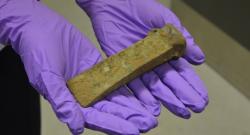 Jersey - A Late Bronze Age hoard has been uncovered in a field in the Parish of Trinity, Jersey just months after the biggest Celtic coin hoard of all time was unearthed in the Island. It is thought that the find is a Late Bronze Age pottery vessel (around 1000 BC) containing what appear to be weapons and tools. At present, two socketed axe heads have been identified but it is not yet confirmed what else is contained within the vessel. The hoard is being excavated by Jersey Heritage staff, Olga Finch (Curator of Archaeology) and Neil Mahrer (Conservator), Robert Waterhouse of the Société Jersiaise, and Ken, the finder. Yesterday (Tuesday), the vessel was being excavated in the trench to find out more about how it was buried before being taken up in one piece. It will now be opened up in the lab in order that the contents can be fully analysed and identified. The top part of the hoard has been damaged by a plough but it is not yet understood the extent of this damage. The find comes just a few months after an Iron Age hoard containing around 70,000 coins and weighing approximately 3/ 4 of a ton was uncovered in the Parish of Grouville.
Jersey - A Late Bronze Age hoard has been uncovered in a field in the Parish of Trinity, Jersey just months after the biggest Celtic coin hoard of all time was unearthed in the Island. It is thought that the find is a Late Bronze Age pottery vessel (around 1000 BC) containing what appear to be weapons and tools. At present, two socketed axe heads have been identified but it is not yet confirmed what else is contained within the vessel. The hoard is being excavated by Jersey Heritage staff, Olga Finch (Curator of Archaeology) and Neil Mahrer (Conservator), Robert Waterhouse of the Société Jersiaise, and Ken, the finder. Yesterday (Tuesday), the vessel was being excavated in the trench to find out more about how it was buried before being taken up in one piece. It will now be opened up in the lab in order that the contents can be fully analysed and identified. The top part of the hoard has been damaged by a plough but it is not yet understood the extent of this damage. The find comes just a few months after an Iron Age hoard containing around 70,000 coins and weighing approximately 3/ 4 of a ton was uncovered in the Parish of Grouville.
http://jersey.isle-news.com/archives/late-bronze-age-hoard-discovered-in-jersey/13986/
FRANCE – 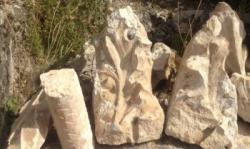 Nègrepelisse - Le chantier du château de Nègrepelisse avance et des changements sont perceptibles sur l'esplanade. À partir des vestiges révélés par des fouilles archéologiques et des travaux d'embellissement, un nouveau bâtiment sera créé pour accueillir le centre d'art et de design La Cuisine. Certains murs présents dans la cour sont déconstruits en collaboration avec l’Inrap. Lors de ces phases de déconstruction, l'institut a découvert des pierres représentant un intérêt patrimonial et architectural, qui seront conservés. Les chercheurs seront présents ponctuellement pour suivre le chantier.
Nègrepelisse - Le chantier du château de Nègrepelisse avance et des changements sont perceptibles sur l'esplanade. À partir des vestiges révélés par des fouilles archéologiques et des travaux d'embellissement, un nouveau bâtiment sera créé pour accueillir le centre d'art et de design La Cuisine. Certains murs présents dans la cour sont déconstruits en collaboration avec l’Inrap. Lors de ces phases de déconstruction, l'institut a découvert des pierres représentant un intérêt patrimonial et architectural, qui seront conservés. Les chercheurs seront présents ponctuellement pour suivre le chantier.
http://www.ladepeche.fr/article/2012/10/11/1461921-negrepelisse-des-pierres-anciennes-decouvertes-sur-le-chantier-du-chateau.html
FRANCE – Maillé - Dans le cadre de l'aménagement de la future ligne à grande vitesse (LGV) Tours-Bordeaux, un chantier de fouilles archéologiques préventives a été réalisé à Maillé. Il a mis à jour des éléments de silexs taillés qui témoignent d'une première occupation préhistorique. Une installation gauloise, la présence d'un domaine agricole antique et le développement d'une exploitation à l'époque carolingienne ont également été révélés par divers vestiges de maçonnerie, des fossés, des fragments de céramiques, d'amphore ou d'enduits.
http://www.lanouvellerepublique.fr/Toute-zone/Actualite/Environnement/n/Contenus/Articles/2012/10/11/PATRIMOINE-LGV-portes-ouvertes-sur-les-fouilles-de-Maille
FRANCE – 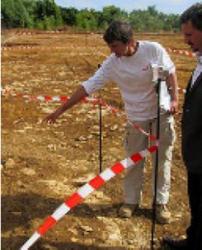 Brion - Depuis l'an dernier, les archéologues de l'Inrap s'affairent sur les 3,3 hectares du site où sera construite la déviation de Brion. La première et la deuxième étapes, encore en cours, des fouilles préventives, ont révélé un site antique réoccupé au Moyen Age. L'équipe de 9 archéologues a découvert étonnamment peu de mobilier, mais les fondations de bâtiments de l'époque antique, visiblement organisés autour d'un chemin ancien. La structure des anciennes constructions leur laisse penser qu'il a pu s'agir d'un relais pour les voyageurs, puisque l'un des bâtiments, de plus de 300 m², pourrait avoir eu une vocation hôtelière. Une salle avec un hypocauste (1) a également été bien conservée. A priori, l'occupation aurait été plutôt courte à cette époque, mais le site et les constructions auraient été réutilisés au Moyen Age. D'après les 14 sépultures mises au jour, l'occupation médiévale pourrait avoir commencé avant le XIIe siècle, mais il est n'est pas assuré que le site ait été utilisé de façon continue entre les deux périodes. Seule l'analyse en laboratoire des éléments retrouvés permettra de la dater plus précisément. Quoi qu'il en soit, à l'époque médiévale, des galeries latérales ont été ajoutées au grand bâtiment, d'autres constructions se sont ajoutées. Des silos et trous de poteaux d'une grande densité laissent à penser que le site était alors consacré à l'agriculture, même si la présence abondante de grands foyers et de scories de fer peut également indiquer une activité métallurgique. Reste aux archéologues à fouiller la partie du site aujourd'hui enfouie sous la D938, qui pourrait révéler encore quelques indices sur la vie passée du site, voire quelques surprises.
Brion - Depuis l'an dernier, les archéologues de l'Inrap s'affairent sur les 3,3 hectares du site où sera construite la déviation de Brion. La première et la deuxième étapes, encore en cours, des fouilles préventives, ont révélé un site antique réoccupé au Moyen Age. L'équipe de 9 archéologues a découvert étonnamment peu de mobilier, mais les fondations de bâtiments de l'époque antique, visiblement organisés autour d'un chemin ancien. La structure des anciennes constructions leur laisse penser qu'il a pu s'agir d'un relais pour les voyageurs, puisque l'un des bâtiments, de plus de 300 m², pourrait avoir eu une vocation hôtelière. Une salle avec un hypocauste (1) a également été bien conservée. A priori, l'occupation aurait été plutôt courte à cette époque, mais le site et les constructions auraient été réutilisés au Moyen Age. D'après les 14 sépultures mises au jour, l'occupation médiévale pourrait avoir commencé avant le XIIe siècle, mais il est n'est pas assuré que le site ait été utilisé de façon continue entre les deux périodes. Seule l'analyse en laboratoire des éléments retrouvés permettra de la dater plus précisément. Quoi qu'il en soit, à l'époque médiévale, des galeries latérales ont été ajoutées au grand bâtiment, d'autres constructions se sont ajoutées. Des silos et trous de poteaux d'une grande densité laissent à penser que le site était alors consacré à l'agriculture, même si la présence abondante de grands foyers et de scories de fer peut également indiquer une activité métallurgique. Reste aux archéologues à fouiller la partie du site aujourd'hui enfouie sous la D938, qui pourrait révéler encore quelques indices sur la vie passée du site, voire quelques surprises.
http://www.lanouvellerepublique.fr/Deux-Sevres/Loisirs/24H/n/Contenus/Articles/2012/10/11/Fouilles-de-Brion-de-l-antique-et-du-medieval
ISRAËL – 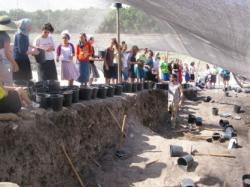 Tel Esur – The third season of excavations at Tel Esur exposed a diverse array of discoveries including 14th-century B.C.E. figurines, Canaanite fortifications and an Iron Age administrative structure. The multi-period site is well suited for its multi-generational excavation team: Over 500 Israeli youths joined University of Haifa archaeologists in Israel’s largest community archaeological dig. The youth team exposed strata from as early as the Middle Bronze Age (19th-16th centuries B.C.E.), and have uncovered large-scale public architecture, domestic structures and unique small finds, including a Late Bronze Age Egyptian scarab from the 14th century B.C.E.
Tel Esur – The third season of excavations at Tel Esur exposed a diverse array of discoveries including 14th-century B.C.E. figurines, Canaanite fortifications and an Iron Age administrative structure. The multi-period site is well suited for its multi-generational excavation team: Over 500 Israeli youths joined University of Haifa archaeologists in Israel’s largest community archaeological dig. The youth team exposed strata from as early as the Middle Bronze Age (19th-16th centuries B.C.E.), and have uncovered large-scale public architecture, domestic structures and unique small finds, including a Late Bronze Age Egyptian scarab from the 14th century B.C.E.
http://www.biblicalarchaeology.org/daily/news/the-young-meet-the-old/
HAWAII – Kakaako - Archeologists surveying the 20-mile route of the planned Honolulu rail transit line over the weekend discovered what appears to be ancient Hawaiian burial sites in Kakaako. The Honolulu Authority for Rapid Transportation web site documents the October 6 find on Halekauwila Street as "Disarticulated human remains from at least two separate individuals" and a "single, intact human burial." About three weeks ago on September 12, a single human bone fragment was unearthed near Cooke Street in Kakaako, but later left intact and covered so the archaeological firm could excavating the surrounding area. The City & County of Honolulu originally began construction on the controversial elevated steel on steel rail project this summer, claiming officials could segment the project into four parts, and complete the archeological surveys one section at a time.
http://www.hawaiireporter.com/additional-hawaiian-burials-found-along-planned-rail-route/123
TURQUIE – 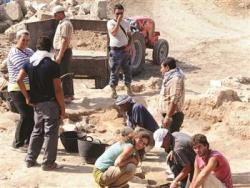 Karkamış - Artifacts discovered during excavations at Gaziantep’s Karkamış ancient site were presented to the press. The pieces were found in a 663,000 square-meter area following the clearance of mines in a military area near the Syrian border. The presented discoveries from the Iron, Early Bronze and Middle Ages were all found in a 663,000 square-meter area. Marchetti told press members that the Karkamış ancient city covered an area of 90 hectares, 55 hectares of which lie within the Turkish border and 35 hectares of which lie within the Syrian border. There is currently no chance of excavating the area within the Syrian border. Also speaking at the presentation, Gaziantep Mayor Asım Güzelbey said the peace treaty between Egyptian Pharaoh Ramesses II and the Hittite Hattusha was signed on this land over 3,000 years ago. The clearing of land mines from the Karkamış ancient site, which was first discovered in the 1870s, began two years ago. Approximately 1,200 mines were found with the help of dogs and removed, and quality control in the area was carried out according to U.N. standards after the clearance. During the clearance, coins and historical artifacts were discovered and given to the museum directorate.
Karkamış - Artifacts discovered during excavations at Gaziantep’s Karkamış ancient site were presented to the press. The pieces were found in a 663,000 square-meter area following the clearance of mines in a military area near the Syrian border. The presented discoveries from the Iron, Early Bronze and Middle Ages were all found in a 663,000 square-meter area. Marchetti told press members that the Karkamış ancient city covered an area of 90 hectares, 55 hectares of which lie within the Turkish border and 35 hectares of which lie within the Syrian border. There is currently no chance of excavating the area within the Syrian border. Also speaking at the presentation, Gaziantep Mayor Asım Güzelbey said the peace treaty between Egyptian Pharaoh Ramesses II and the Hittite Hattusha was signed on this land over 3,000 years ago. The clearing of land mines from the Karkamış ancient site, which was first discovered in the 1870s, began two years ago. Approximately 1,200 mines were found with the help of dogs and removed, and quality control in the area was carried out according to U.N. standards after the clearance. During the clearance, coins and historical artifacts were discovered and given to the museum directorate.
http://www.hurriyetdailynews.com/karkamis-artifacts-revealed-to-media.aspx?pageID=238&nID=32114&NewsCatID=375
TURQUIE – 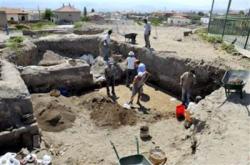 Kültepe /Kanesh - Some 24,000 ancient trade documents have been discovered in the Central Anatolian province of Kayseri, at the ancient city Kültepe (Kanesh), according to the city's mayor, Mehmet Özhaseki. Checks and bills dating back 6,000 years were discovered in excavations in Kayseri, Özhaseki said while attending the 15th Antalya Industrialist and Businessmen’s meeting today.,"Trade is traditionally crucial for us. The clans who lived in this city 6,000 years ago founded trade colonies and exchanged goods with people traversing Mesopotamia. Generally pots … sculptures or artwork are discovered in excavations in other parts of Anatolia, but all the discoveries made in Kayseri were of lots of bills, invoices, checks,” he said. “They are all about trade – sales, repo, rates [and more]."
Kültepe /Kanesh - Some 24,000 ancient trade documents have been discovered in the Central Anatolian province of Kayseri, at the ancient city Kültepe (Kanesh), according to the city's mayor, Mehmet Özhaseki. Checks and bills dating back 6,000 years were discovered in excavations in Kayseri, Özhaseki said while attending the 15th Antalya Industrialist and Businessmen’s meeting today.,"Trade is traditionally crucial for us. The clans who lived in this city 6,000 years ago founded trade colonies and exchanged goods with people traversing Mesopotamia. Generally pots … sculptures or artwork are discovered in excavations in other parts of Anatolia, but all the discoveries made in Kayseri were of lots of bills, invoices, checks,” he said. “They are all about trade – sales, repo, rates [and more]."
http://www.hurriyetdailynews.com/
INDE –  Odisha - A team of experts of Archaeological Survey of India (ASI) led by Deputy Superintendent Jeetendra Kumar Pattnaik on Monday inspected the 12th century Jagannath Temple, a day after a stone-like structure fell off the outer structure of the temple, leaving a priest injured. However after examination, the ASI officials claimed that it was not a stone but a block of lime plaster. As per official records, tumbling of stones from the temple’s inner roof and outer structure has been noticed since 1842. And on three occasions, huge stone blocks, weighing several tonnes, fell from the ‘Amolaka’ and inner roof of ‘Garbagruha’.
Odisha - A team of experts of Archaeological Survey of India (ASI) led by Deputy Superintendent Jeetendra Kumar Pattnaik on Monday inspected the 12th century Jagannath Temple, a day after a stone-like structure fell off the outer structure of the temple, leaving a priest injured. However after examination, the ASI officials claimed that it was not a stone but a block of lime plaster. As per official records, tumbling of stones from the temple’s inner roof and outer structure has been noticed since 1842. And on three occasions, huge stone blocks, weighing several tonnes, fell from the ‘Amolaka’ and inner roof of ‘Garbagruha’.
http://newindianexpress.com/states/odisha/article1291610.ece